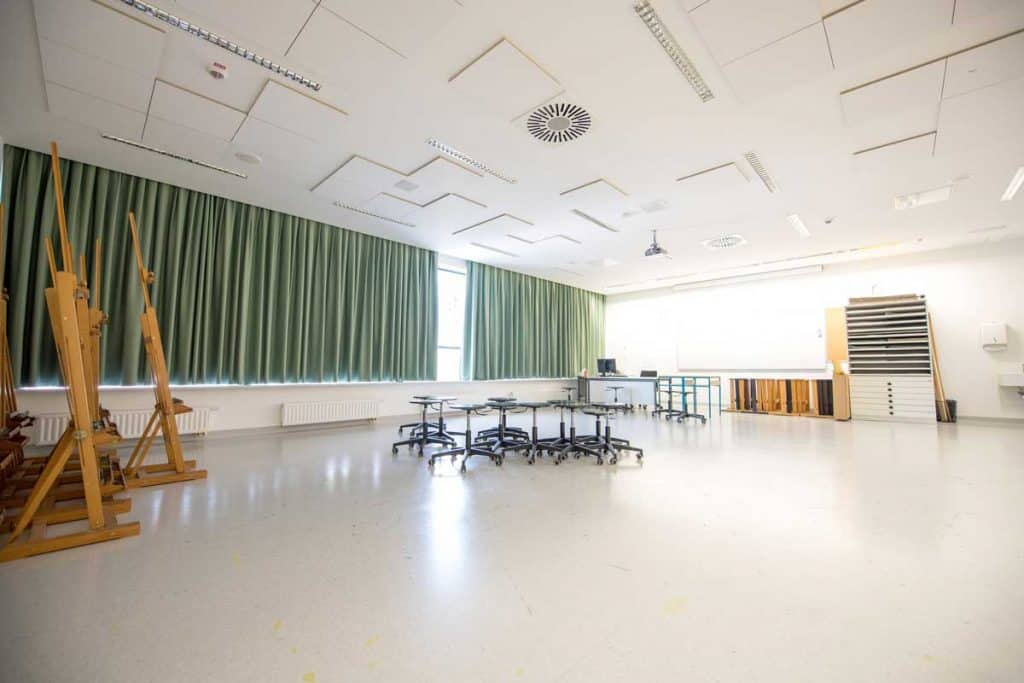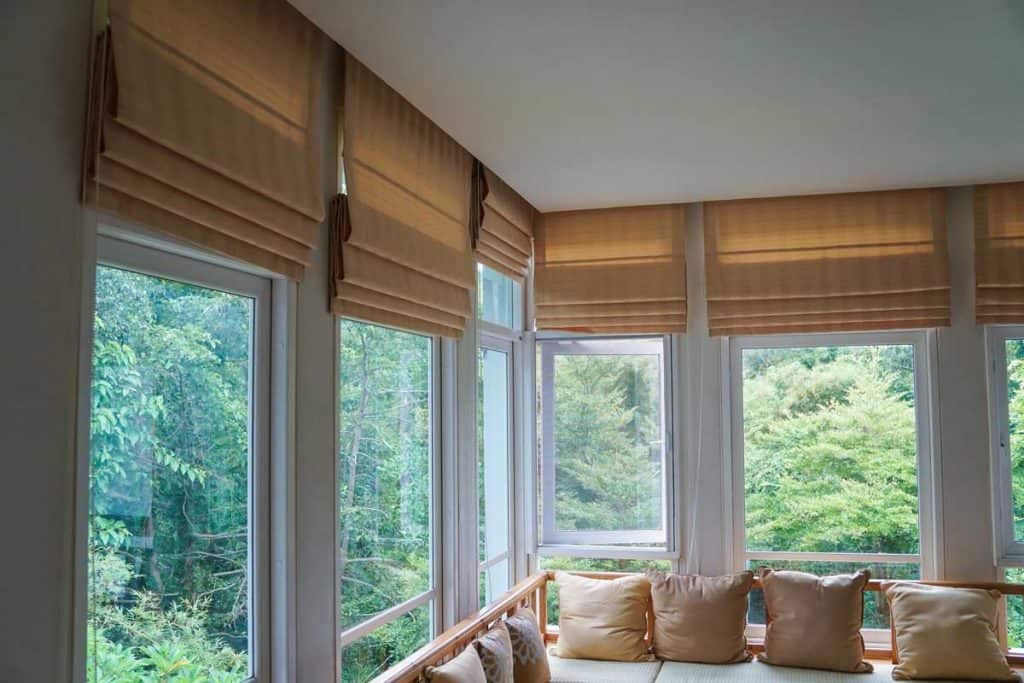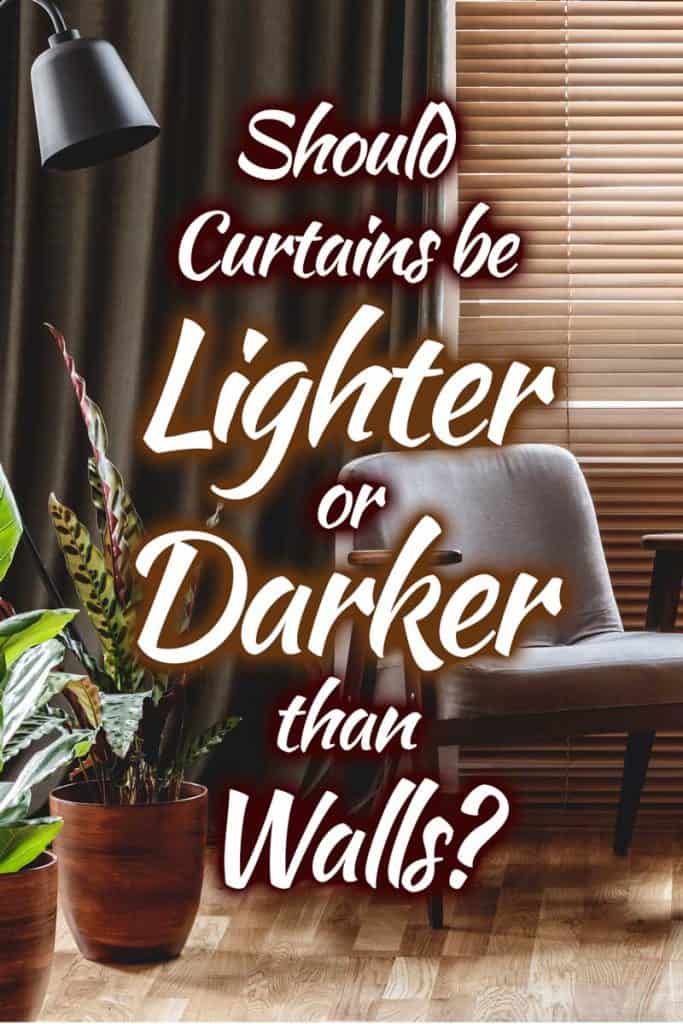When purchasing a home, most people hanker over what color window treatments to buy. While many factors may affect this decision, such as personal preference, sense of style, furniture type, etc., the most obvious one is the color or your walls. This begs the question, ‘should curtains be lighter or darker than walls?’
Whether your walls are a warm (red, orange, yellows or beige) or cool (green, blue, purple or gray) hue, it is often suggested that window treatments be of a similar tone. Choosing a color at least one shade lighter or darker than the version on the wall is recommended. Coordinating curtains or blinds to match the furniture in the room is also a good idea.
Now that you know it is best to choose window treatments in colors lighter or darker than the surrounding walls, let’s take a closer look at this concept in more detail below. We will discuss what color curtains go with gray walls, whether curtains should be the same color as the walls, what is the best color for curtains and is it necessary for all curtains in a home to match.
So, if you’re ready to learn more about coordinating curtains to match walls in a room, then let’s get started!
What Color Curtains Go with Gray Walls?
To choose curtain colors that complement gray walls, you need to be aware of the undertones involved. If the gray has green or blue undertones, it is considered a cool color. If the gray is tinged with pink or has a red base, it is then classified as a warm color. Pinkish-gray shades are often referred to as taupe, which is essentially a color between gray and brown.

We may include affiliate links and curated AI content to highlight top design styles.
Since gray is deemed a ‘neutral’ shade, you can pair a variety of colors with it easily. Just keep in mind the undertones in the paint and choose cool-colored window treatments for cool-gray walls and warm-colored window treatments for warm-gray walls. You must also keep in mind the furniture shades in the room as well and coordinate curtains and blinds accordingly.
On the flip side, however, selecting window treatments in the complement or opposite color of the gray tone on the walls provides the greatest contrast. This is great if you prefer the colors in your room to pop rather than blend. Let’s take a closer look at how to do this below.
Warm-Gray Walls and Green Curtains/Blinds

Since green is the complementary color to the red undertones in warm-gray, olive green curtains or blinds pair perfectly with medium warm-gray walls while providing a natural contrast. Dark warm-gray walls pop with mint-green window treatments and add an unexpected, fresh ‘twist’ to any room. For a more subtle effect, pair light to medium warm-gray walls with dark green-gray curtains or blinds.
Warm-Gray Walls and Red, Orange, Coral or Plum Curtains/Blinds
Light warm-gray walls harmonize well with window treatments derived from the same color family, which is red, orange-red or coral. Fiery-orange brown curtains or blinds will make a room with lighter warm-gray walls look hip and modern. Some warm-gray walls contain undertones of pink and in such cases, a tone-on-tone effect using plum-colored curtains with a satin sheer works really well.
Green-Gray Walls and Red, Orange, Coral or Brown Curtains/Blinds
Red curtains look stunning against a green-gray wall, especially if a red accent chair is also part of the room! Nature-inspired, patterned curtains with shades of green-gray and orange-brown also look beautiful against a medium green-gray wall. For a fresh approach with a modern flair, pair dark plum window treatments with lighter green-gray walls and add hints of black throughout the room.
Tone-on-Tone Effect
This is basically the idea of using cool (or warm) window treatments in rooms with cool (or warm) paint colors. Light blue-gray walls, for example, work beautifully with darker (or lighter) blue-gray curtains and blinds. For a sophisticated twist, try pairing blue-gray walls and blue-gray curtains featuring glimmering fabrics and floral patterns with antique black curtain rods.
Are White Curtains a Good Idea?

White curtain and blinds soften windows and brighten a room. They are also easier to work with from a decorative point of view, as darker window treatments, because they are more visually dominating, can negatively affect a room’s aesthetic appeal.
Since white is considered neutral, almost any wall shade will work, provided that it is darker and contains similar undertones. For example, bright, ‘true’ white window treatments look great with cool wall colors whereas more beigey-colored curtains or blinds work better with warm wall shades.
Love that look? Click here for white sheer curtains on Amazon.
Should Curtains be the Same Color as the Wall?
For a classic, elegant look, choose solid-colored curtains in the same color family as the walls. However, be sure to choose a slightly lighter or darker version of the wall shade for best tone-on-tone results.

Traditionally, curtains and blinds were chosen in colors opposite or complementary on the color wheel to that of the paint shade. However, a more contemporary approach of choosing tone-on-tone shades for window treatments and walls is becoming more and more popular nowadays.
Should Blinds be Lighter or Darker than Walls?

In order for blinds to avoid getting ‘lost’ in the interior of a room, they should be lighter or darker than the walls. Blinds that are very similar in color to that of the walls, will disappear and go unnoticed. It’s best to choose blinds in shades that complement the furniture as well as the wall coloring or wallpaper in the room.
Should All Curtains in a Room Match?
If you prefer your window treatments to be the same throughout your home, that’s fine, as long as the furniture and décor also match. If your furniture style, whether it be mid-century modern, industrial, nautical, Scandinavian, bohemian, farmhouse, urban modern or shabby chic, varies from room to room, then your curtains or blinds can be different as well. The idea is to make sure the wall colors, window treatments and furnishings complement each other in any given room.
What is the Best Color for Curtains?

The best color for curtains is at least one shade lighter or darker than the walls with similar undertones. For example, dark-colored curtains in deep, rich shades look stunning against light-colored walls painted warm-white, cream, light-gray or light taupe. By this standard, light-colored window treatments look great against darker walls in shades of blue, green, gray or brown.
Do Dark Curtains or Walls Make a Room Look Smaller
There is a common misconception that dark curtains or walls make a room look smaller. It is not so much the shade as it is the amount of color in a room that affects how ‘big’ it feels. Heavily patterned, multi-colored window treatments and furniture can also create a sense of less space in a room.

Therefore, to keep the room looking airy and open, choose tone-on-tone shades for your walls and window treatments. And remember, brighter rooms always look bigger so keep your windows clean and open whenever possible and be sure to add plenty of lighting in the form of chandeliers, ceiling and wall-mounted fixtures, track lighting, floor and table lamps, etc. throughout the room.
Summary
Choosing the right curtains or blinds, depending on the color of your walls, can turn an ordinary room into something extraordinary! Although colors and patterns will vary, depending on your personal preferences and sense of style, it is best to choose window treatments at least one shade lighter or darker than the walls. Coordinating curtains and blinds to match your furniture colors is also worth considering.
Good luck and happy decorating! And in case you want to read more about decorating with curtains, try these -
Types of Curtain Hooks and Tiebacks (Including examples)
How to Use Shabby Chic White Ruffled Curtains in Your Room Design
How To Choose Curtains For The Nursery?







My old cape code has painted white chair rail. The upper wall is painted in Behr Park Avenue (taupe) and the lower wall is painted Smokey Trout(deep gray in appearance with northern light exposure).
There is a red oak 1800 fireplace mantle ( the color of the wood appears to have a golden like color) framed by a window on each side and this wall is painted the Park Avenue paint color.
Dark stained hardwood floors.The furniture is dark wood with dark brown leather (Stickley)
The windows have 12 panes.I desire a solid color curtain. I went to 6 stores and found it most difficult to find a curtain color that even close to the Behr Park Avenue paint color. Would you have any suggestions.
In my opinion, I would think that beige woould look fine with all those colours or an off cream plain curtain
This article provides details about curtains lighter darker walls. This blog happens to be one of the best blog, which give proper details about it. I enjoyed reading this blog and would suggest others too, and you would get to read about it in this link.Do visit this Cedarblinds.co.nz For vital information that can be used again by anyone.
My chairset is brown and the walls are white.i want to use burnt orange but not sure what othercolour curtain to blend it with
I have benjin moore maple syrup on my walls. My furniture is brown tones with blue accent. What color curtains?
I have charcoal walls or dark grey should i go with lighter curtains?